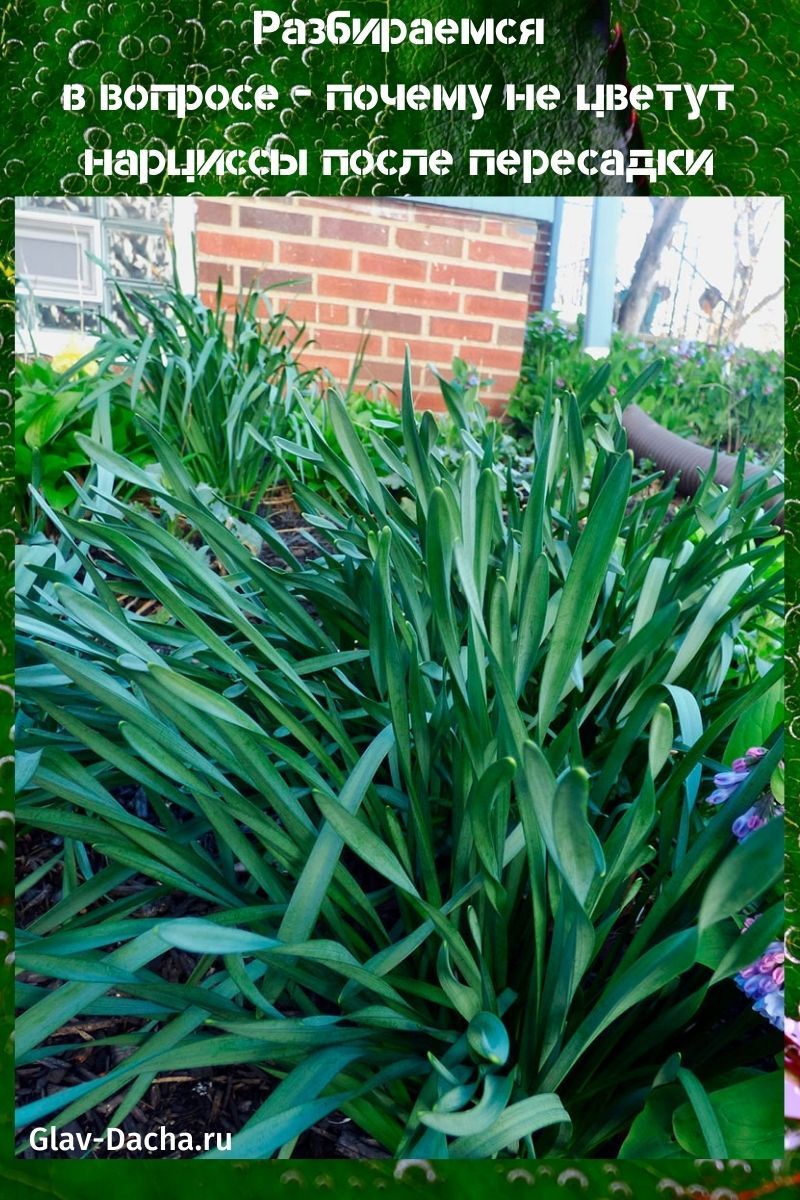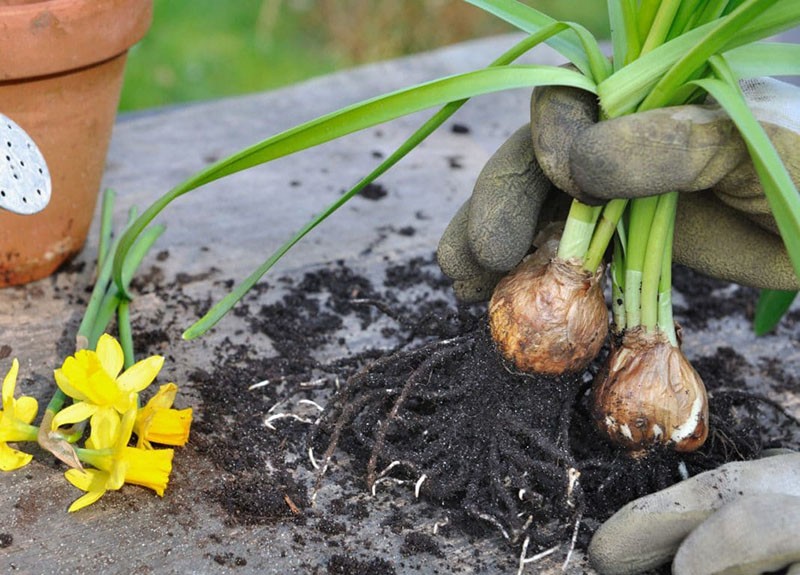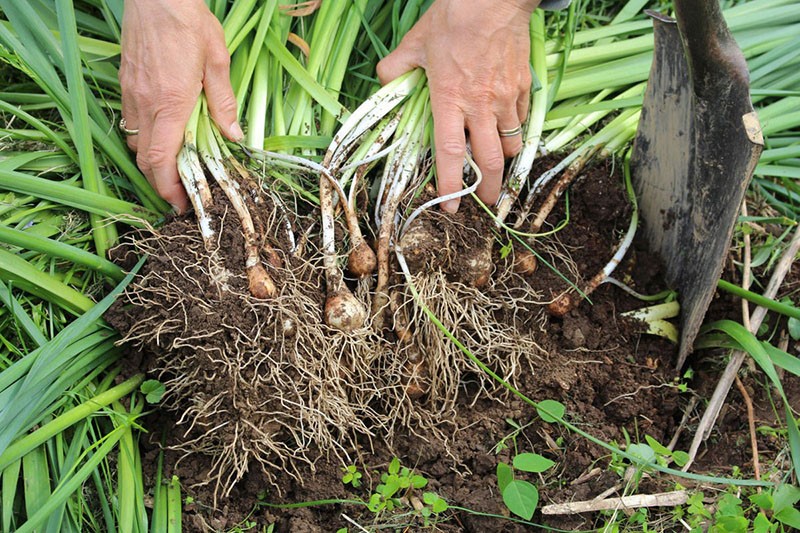We understand the question - why daffodils do not bloom after transplantation
 Blooming primroses are one of the first and most long-awaited joys of any gardener. It is all the more offensive to observe a dull bunch of greenery on a flower bed all spring. Why don't daffodils bloom after transplantation? There may be several reasons, but first, let's make sure that we transplanted the flowers correctly.
Blooming primroses are one of the first and most long-awaited joys of any gardener. It is all the more offensive to observe a dull bunch of greenery on a flower bed all spring. Why don't daffodils bloom after transplantation? There may be several reasons, but first, let's make sure that we transplanted the flowers correctly.
How to transplant daffodils correctly

If necessary, primroses are transplanted at the end of March-April. But flowers transplanted in spring may bloom poorly in the first year or not have time to pick up buds at all. If the right time is missed, you should not wonder why daffodils do not bloom, and there are only leaves in the flower bed. For a year, the plants will get stronger and bloom next spring.
For planting, large ripe bulbs with intact smooth skin are selected. In order to prevent fungal diseases and root rot, planting material is soaked in an antiseptic solution. The best antimicrobial agent for the treatment of bulbous is the drug "Maxim".
In one container, along with daffodils, you can pickle any other bulbous crops or seed potatoes.
 For daffodils, a well-lit place with fertile, drained soil without stagnant water is assigned. A hole is dug under the future spring flower bed with a depth of at least 20 cm. Coarse sand is poured at the bottom, a little phosphorus-potassium fertilizer with microelements is added. All are mixed and slightly compacted.
For daffodils, a well-lit place with fertile, drained soil without stagnant water is assigned. A hole is dug under the future spring flower bed with a depth of at least 20 cm. Coarse sand is poured at the bottom, a little phosphorus-potassium fertilizer with microelements is added. All are mixed and slightly compacted.
 Planting material is placed at a depth of 15 cm or 3 heights of medium-sized bulbs at a distance of 10-12 cm. Then they are covered with earth and watered abundantly with warm water. After emergence, daffodils are fertilized with nitrogen fertilizer. Urea or ammonium nitrate, diluted infusion of weeds or mullein are suitable.
Planting material is placed at a depth of 15 cm or 3 heights of medium-sized bulbs at a distance of 10-12 cm. Then they are covered with earth and watered abundantly with warm water. After emergence, daffodils are fertilized with nitrogen fertilizer. Urea or ammonium nitrate, diluted infusion of weeds or mullein are suitable.
If the site is hosted moles or mice, plant the daffodils in a box made of fine mesh. Moisture and nutrients will freely pass through the cells, and rodents will have to bypass the juicy onions.
A gardener who follows these rules should not have a question why daffodils do not bloom after transplantation. If the spring flower bed still does not please the eye with bright colors, there are a few more conditions to check.
Why daffodils don't bloom after transplant - four non-obvious reasons
 Primroses are considered unpretentious, but in some cases they can be stubborn. A summer resident who is wondering how to make daffodils bloom should take into account a few more points that prevent spring beauties from picking up a lot of buds and charming everyone with delicate colors and a subtle aroma.
Primroses are considered unpretentious, but in some cases they can be stubborn. A summer resident who is wondering how to make daffodils bloom should take into account a few more points that prevent spring beauties from picking up a lot of buds and charming everyone with delicate colors and a subtle aroma.
Unsuitable soil
 Daffodils love neutral or slightly acidic soils with a pH of 5 to 7. Excessively acidic soil must be deoxidized beforehand.
Daffodils love neutral or slightly acidic soils with a pH of 5 to 7. Excessively acidic soil must be deoxidized beforehand.
To do this, under the autumn digging, they bring in:
- fluff lime;
- a piece of chalk;
- ash;
- dolomite flour.
 Deoxidizers are evenly scattered over the surface of the soil, consuming no more than 1 glass per square meter.
Deoxidizers are evenly scattered over the surface of the soil, consuming no more than 1 glass per square meter.
On very acidic soils, add wood ash to the sand in the drain and mix. Ash acts slowly, gradually decreasing acidity over several years.
Water the flowerbed 2-3 times a season with water and dolomite flour in a ratio of 100 g per 10 liters.Such dressing will deacidify and fill the lack of calcium and magnesium in the soil.
Lack of free space
 It would seem that such a problem should not remain after the transplant. If the daffodils are still not in bloom, the grower has planted the bulbs too thickly and lacks nutrition. In good conditions, these flowers grow very quickly and they may need a transplant not once every 4–5 years, but in a year or two. The same effect can occur if a new flower bed is laid out on poor soil.
It would seem that such a problem should not remain after the transplant. If the daffodils are still not in bloom, the grower has planted the bulbs too thickly and lacks nutrition. In good conditions, these flowers grow very quickly and they may need a transplant not once every 4–5 years, but in a year or two. The same effect can occur if a new flower bed is laid out on poor soil.
To check, you should carefully excavate the soil in the middle of planting. If the bulbs are located close to each other, another transplant is necessary. The plot has not yet grown, and the flower garden looks dull? Feed it with a complete complex mineral fertilizer and it will bloom without delay.
Excess nitrogen
 Nitrogen is the most important nutrient, without which photosynthesis and other metabolic processes are impossible. But in the case of flowering plants, the dose of nitrogen applied must be carefully calculated. Otherwise, there is every chance of getting a luxurious green lawn instead of a fragrant meadow. Plants receiving increased amounts of nitrogen increase green mass at the expense of flowering.
Nitrogen is the most important nutrient, without which photosynthesis and other metabolic processes are impossible. But in the case of flowering plants, the dose of nitrogen applied must be carefully calculated. Otherwise, there is every chance of getting a luxurious green lawn instead of a fragrant meadow. Plants receiving increased amounts of nitrogen increase green mass at the expense of flowering.
If the leaves are well developed, bright green in color, but for some reason the daffodils themselves do not bloom, you need to do the following: stop nitrogen feeding and increase the proportion of phosphorus and potassium.
2-3 weeks before flowering, spraying the flower beds with a solution helps boric acid in a proportion of 1-2 g per bucket of water.
During the season, daffodils require phosphorus and potassium, 40-50 g per square meter. Since granular phosphorus is absorbed by the microbiota extremely slowly, it is added in liquid form.
The recipe for preparing a liquid top dressing is simple and suitable for most vegetables and flowers:
- A liter can of ordinary or double superphosphate is poured into a bucket, poured with boiling water, grinded with a mortar, mixed thoroughly and the volume is brought to 10 liters.
- After a day, the infusion is drained, 0.5 l of table vinegar is added to it and left for another day.
- For watering plants, the resulting liquid is diluted with clean water 10 times.
Before applying top dressing, the flower garden is watered with clean water.
Pruning leaves too early
 For the bulb babies to mature well, the plant needs photosynthesis. Therefore, daffodil leaves should not be cut off immediately after flowering. It is necessary to wait for natural wilting, after which an embryo of a future flower is formed in the bulb.
For the bulb babies to mature well, the plant needs photosynthesis. Therefore, daffodil leaves should not be cut off immediately after flowering. It is necessary to wait for natural wilting, after which an embryo of a future flower is formed in the bulb.
After digging, all the children are separated and sorted. It is not recommended to leave small onions for planting. Even with good care, they are unlikely to form a flower bud and will not bloom. Also, when sorting, planting material with traces of diseases and gnawed by pests is rejected.
Beloved by everyone, white and yellow primroses are unpretentious, but require some attention. If you take into account all the subtleties described in the article, the question of why daffodils do not bloom after transplantation will never arise before the gardener, and the spring flower bed will become a real decoration of the site.